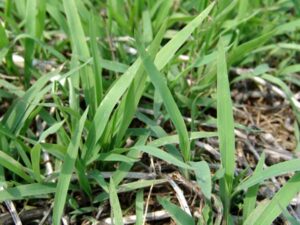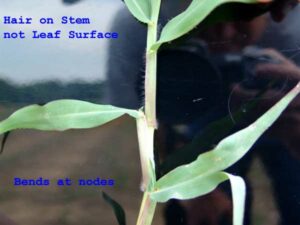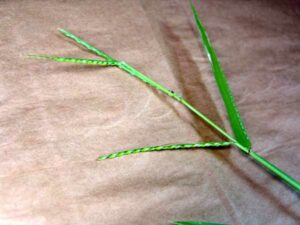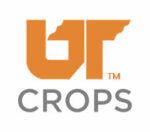LINKS
Broadleaf Signalgrass (Brachiaria platyphylla [Griseb.] Nach.)
Classification and Description:
 Broadleaf signalgrass is a member of the Grass Family (Poaceae). It is a summer annual grass that is native to the southeastern United States. It is commonly found throughout Tennessee and is a problem weed species, especially in corn production. The first leaf blade of broadleaf signalgrass seedlings is linear and parallel to the ground. Leaves lack hairs, except at the margins and collars and have no auricles. The ligule comprised of a narrow membrane fringed with hairs. Blades may also be maroon-tinged when broadleaf signalgrass is in the seedling stage. Mature plants can be described as growing semi-prostrate on the ground, branched and bent at the nodes. This species may reach heights of up to 3 feet. Leaves are rolled in the bud and lack hairs on either leaf surface.
Broadleaf signalgrass is a member of the Grass Family (Poaceae). It is a summer annual grass that is native to the southeastern United States. It is commonly found throughout Tennessee and is a problem weed species, especially in corn production. The first leaf blade of broadleaf signalgrass seedlings is linear and parallel to the ground. Leaves lack hairs, except at the margins and collars and have no auricles. The ligule comprised of a narrow membrane fringed with hairs. Blades may also be maroon-tinged when broadleaf signalgrass is in the seedling stage. Mature plants can be described as growing semi-prostrate on the ground, branched and bent at the nodes. This species may reach heights of up to 3 feet. Leaves are rolled in the bud and lack hairs on either leaf surface.
Leaf blades are overall short and wide in appearance and have a distinct midvein. Occasionally, sheaths may have short hairs at the base as well. It is possible for broadleaf signalgrass to root at the lower stem nodes. Flowering typically occurs in late summer and early fall (July to Sept.) Each seedhead has 2 to 6 “branches” that can be 1 to 3 ½ inches long. Spikelets are flattened in appearance. Broadleaf signalgrass produces many seeds per plant.
 Broadleaf signalgrass is similar in appearance to large crabgrass, but careful inspection of the plants will lead to proper identification. A major difference between the two species is that crabgrass is hairy on the upper leaf surface whereas broadleaf signalgrass lacks hairs. In addition the ligule of broadleaf signalgrass is a small membrane fringed with a ring of hairs compared to the large membrane-like ligule for crabgrass.
Broadleaf signalgrass is similar in appearance to large crabgrass, but careful inspection of the plants will lead to proper identification. A major difference between the two species is that crabgrass is hairy on the upper leaf surface whereas broadleaf signalgrass lacks hairs. In addition the ligule of broadleaf signalgrass is a small membrane fringed with a ring of hairs compared to the large membrane-like ligule for crabgrass.
Weed Status and Injury:
Recent research at the University of Tennessee has shown that broadleaf signalgrass can reduce corn yield in excess of 30%. Broadleaf signalgrass is a rapidly spreading, serious problem weed in Tennessee corn. Though it is often confused with large crabgrass, it is much more difficult to control with preemergence herbicides. Broadleaf signalgrass is very competitive and is a prolific seed producer. If not controlled in continuous no-till, a tremendous seed reserve can build on top of the soil and residue, making preemergence control difficult. This is particularly true if frequent, heavy rains occur during the first two weeks following planting.
Management Considerations:
 Management of broadleaf signalgrass is a consistent problem in row crop agriculture throughout Tennessee. Signalgrass will emerge from April through July in Tennessee. This large window of potential emergence makes it difficult to manage. In-crop systemic herbicides like glyphosate will do a good job controlling what has emerged but have no residual to control later emergence. The most consistent control of broadleaf signalgrass can be achieved with a full rate of a PRE applied herbicide followed by a POST emergence application. Please refer to page 12 of the Weed Control Manual for Tennessee Row Crops PB 1580 for management recommendations.
Management of broadleaf signalgrass is a consistent problem in row crop agriculture throughout Tennessee. Signalgrass will emerge from April through July in Tennessee. This large window of potential emergence makes it difficult to manage. In-crop systemic herbicides like glyphosate will do a good job controlling what has emerged but have no residual to control later emergence. The most consistent control of broadleaf signalgrass can be achieved with a full rate of a PRE applied herbicide followed by a POST emergence application. Please refer to page 12 of the Weed Control Manual for Tennessee Row Crops PB 1580 for management recommendations.
Literature Cited:
Alford JL, Hayes RM, Rhodes GN, Steckel LE and Mueller TC. 2005. Broadleaf signalgrass (Brachiaria platyphylla) interference in corn. Weed Sci. 53:97-100.







